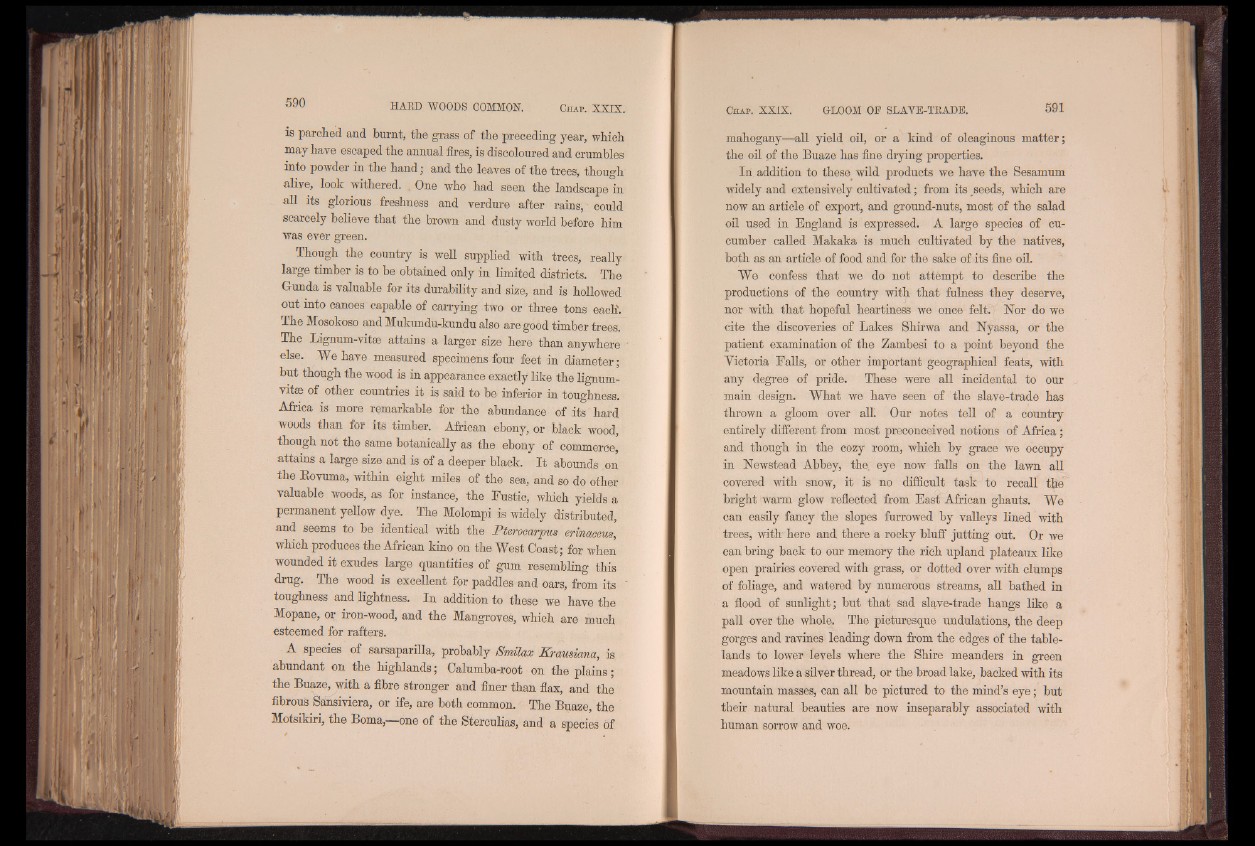
is parched and burnt, the grass of the preceding year, which
may have escaped the annual fires, is discoloured and crumbles
into powder in the hand; and the leaves of the trees, though
alive, look withered. . One who had seen the landscape in
all its glorious freshness and verdure after rains, could
scarcely believe that the brown and dusty world before him
was ever green.
Though the country is well supplied with trees, really
large timber is to he obtained only in limited districts. The
Gunda is valuable for its durability and size, and is hollowed
out into canoes capable of carrying two or three tons each'.
The Mosokoso and Mukundu-kundu also are good timber trees.
The Lignum-vitae attains a larger size here than anywhere
else. We have measured specimens four feet in diameter;
but though the wood is in appearance exactly like the lignum-
vitse of other countries it is said to be inferior in toughness.
Africa is more remarkable for the abundance of its hard
woods than for its timber. African ebony, or black wood,
though not the same botanically as the ebony of commerce,
attains a large size and is of a deeper black. I t abounds on
the Rovuma, within eight miles of the sea, and so do other
valuable woods, as for instance, the Fustic, which yields a
permanent yellow dye. The Molompi is widely distributed,
and seems to be identical with the JPterpcarpus erinaceus,
which produces the African kino on the West Coast; for when
wounded it exudes large quantities of gum resembling this
drug. The wood is excellent for paddles and oars, from its
toughness and lightness. In addition to these we have the
Mopane, or iron-wood, and the Mangroves, which are much
esteemed for rafters.
A species of sarsaparilla, probably Smilax Krausiana, is
abundant on the highlands; Calumba-root on the plains;
the Buaze, with a fibre stronger and finer than flax, and the
fibrous Sknsiviera, or ife, are both common. The Buaze, the
Motsikin, the Boma, one of the Sterculias, and a species of
mahogany—all yield oil, or a kind of oleaginous matter;
the oil pf the Buaze has fine drying properties.
In addition to these wild products we have the Sesamum
widely and extensively cultivated; from its _seeds, which are
now an article of export, and ground-nuts, most of the salad
oil used in England is expressed. A large species of cucumber
called Makaka is much cultivated by the natives,
both as an article of food and for the sake of its fine oil.
We confess that we do not attempt to describe the
productions of the country with that fulness they deserve,
nor with that hopeful heartiness we once felt. Nor do we
cite the discoveries of Lakes Shirwa and Nyassa, or the
patient examination of the Zambesi to a point beyond the
Victoria Falls, or other important geographical feats, with
any degree of pride. These were all incidental to our
main design. What we have seen of the slave-trade has
thrown a gloom over alb Our notes tell of a country
entirely different from most preconceived notions of Africa;
and though in the cozy room, which by grace we occupy
in Newstead Abbey, the. eye now falls on the lawn all
covered with snow, it is no difficult task to recall the
bright warm glow reflected from East African ghauts. We
can easily fancy the slopes furrowed by valleys lined with
trees, with here and there a rocky bluff jutting otit. Or we
can bring back to our memory the rich upland plateaux like
open prairies covered with grass, or dotted over with clumps
of foliage, and watered by numerous streams, all bathed in
a flood of sunlight; but that sad slave-trade hangs like a
pall over the whole. The picturesque undulations, the deep
gorges and ravines leading down from the edges of the tablelands
to lower levels where the Shire meanders in green
meadows like a silver thread, or the broad lake, backed with its
mountain masses, can all be pictured to the mind’s eye; but
their natural beauties are now inseparably associated with
human sorrow and woe.